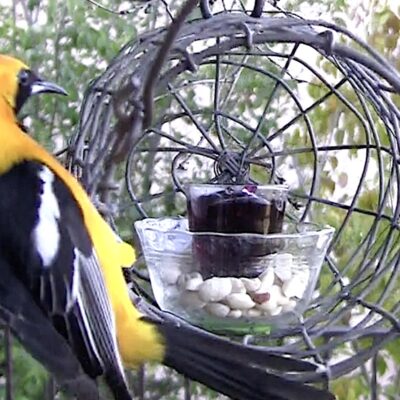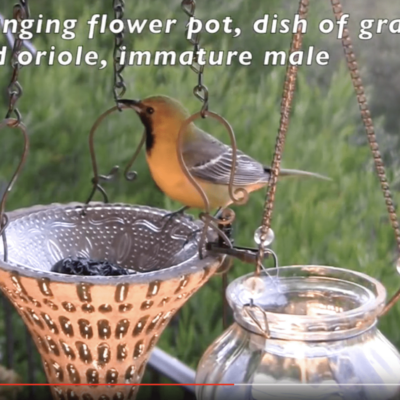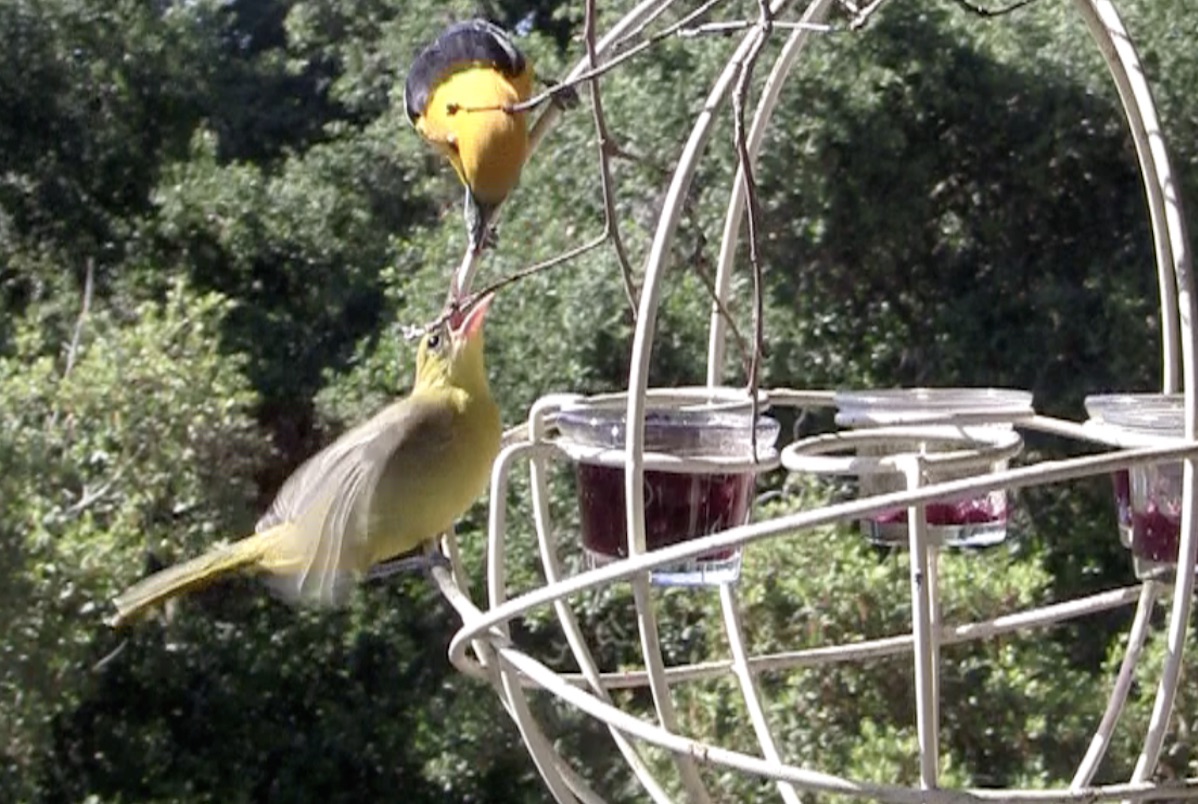
See Baby Birds (Fledglings) at Feeders
Fledglings are toddlers of the bird world: cute, endearing and fun to watch. They're awkward, curious, beg loudly, and don't let their parents out of their sight.
In my new video, you’ll see nine different types of western birds shortly after they've left the nest. In spring and summer, look for these flying jewels in your own backyard.
You'll also see something unexpected: a fledgling cowbird (more about this "brood parasite" below).
Make birdwatching fun and fascinating
Below I explain how to make feeding birds easy, convenient and rewarding. You'll learn how I attract wild birds, make decorative feeders from repurposed items, and where I place them---plus tips if you're new to birdwatching and feeding.
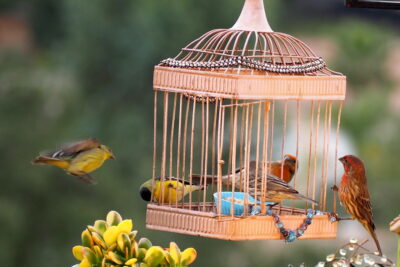
Lesser goldfinches and house finches flock to a bird cage feeder
Attract wild birds
I get kibble and jelly at the market; and suet, raw peanuts and seeds online (shelled for less mess). I don't bother with expensive food like nyger, which is highly perishable and requires a fine-mesh feeder.
Here's what I give the main feathered guests to my garden. All of these birds are common throughout the West.
- American Crow: I provide kibble made for small dogs or cats, and give the birds water to soften it. Crows also appreciate peanuts and protein-rich leftovers.
- California Quail and Mourning Doves forage for seeds that fall from feeders, especially millet.
- California Scrub-Jay: Not fussy but like suet, kibble, and peanuts.
- Finches (House Finch, Lesser Goldfinch): Raw, unsalted, hulled sunflower seeds.
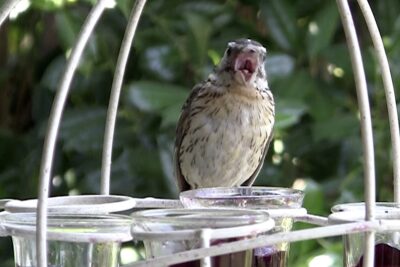
Fledgling grosbeak
- Grosbeak (Black-headed): Suet, grape jelly.
- Oak Titmouse: Raw, unsalted, split peanuts.
- Oriole (Bullock's and Hooded): Grape jelly.
- Occasional and seasonal visitors include chickadees, warblers, wrens, sparrows and nuthatches. All like suet and sunflower seeds.
This Baby's a Parasite?!
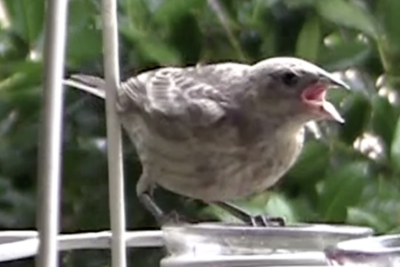
Fledgling cowbirds sound like a dog toy. They squeak loudly and incessantly.
It’s called “brood parasitism:” Cowbirds lay eggs in the nests of other birds, which then raise them. No doubt you'll be surprised, as I was, which sleek birds are the big, fluffy cowbird's foster parents. (From the video.)
Simple decorative feeders
To enhance the beauty and personalities of backyard birds, I repurpose thrift store items as feeders. They're visually intriguing, and besides, commercial feeders are unnecessary. Birds don't care, so long as they can access the food.
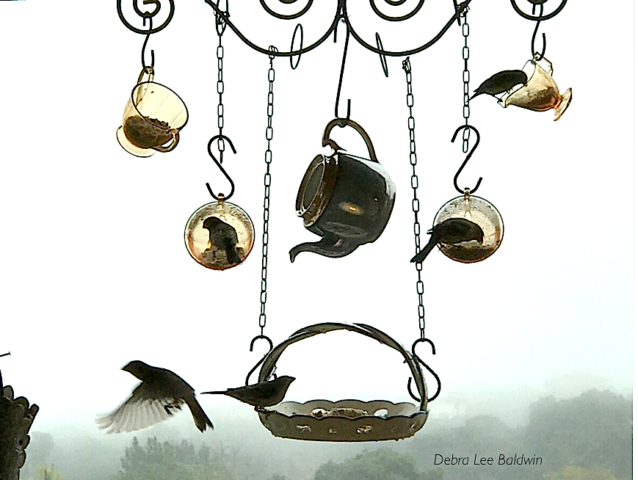
A tea-party grouping makes birds easy to see
I look for wrought iron candleholders, which provide perches and have glass votive cups to hold seed. I also use ornamental bird cages. These allow small birds to get to peanuts while keeping larger birds (like jays) out. Not to mention that watching wild birds exit and re-enter cages makes humans do a double-take!
Where to put feeders
- When placing a feeder, keep in mind whatever is below it will be showered with bird droppings and seed fragments.
- To hang feeders from your eaves, you'll need S-hooks and chains, a hammer, and nails.
Feeders should be:
- Seen easily from indoors
- Near where birds can dart into leafy cover
- High enough to deter cats and rodents
- Quick and easy for you to access
- Close enough to windows so birds can't get enough momentum to slam into them.
If you're new to feeding birds...
- The sound of your voice may not startle birds, but sudden movements will.
- Obtain a Sibley's birding guide specific to your region, or a bird ID app for your phone.
- Get a good pair of binoculars. Mine are Polaris Optics.
- Add a birdbath or fountain. Birds need to drink and bathe, and water attracts those that don't go to feeders.
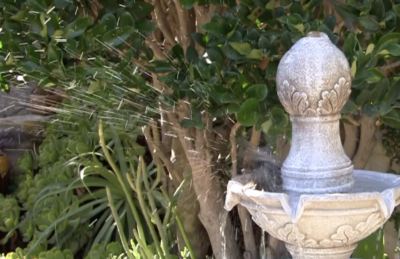
A finch bathes in my garden fountain.
- Be patient. It may take birds several weeks or even months to find a feeder.
- Hang breakable feeders so they won't hit each other if jolted by wings or wind.
- At dusk, bring indoors feeders that might attract nocturnal varmints.
- Keep feeders clean. Wash with soap and hot water, and rinse well.
Btw, I no longer feed hummingbirds because sugar syrup attracts ants, but if you do put up hummingbird feeders, remember that mildew and fungus can be deadly.
Note: Amazon links are affiliate.
On my YouTube channel check out my playlist: Debra’s Bird Feeders.
Which birds are smartest?
I noticed that finches will feed vertically if need be---beaks straight down and tail feathers skyward. This made me wonder what other antics and acrobatics birds might do. So I made a puzzle feeder (link below) to find out. Watch the video to discover, as I did, how clever various birds can be.
Bird Puzzle Feeder: A New Way to Enjoy Your Garden
A “puzzle feeder” is a fun, novel way to observe and enjoy backyard birds. When given a challenge to solve, birds show persistence, determination, and how clever they are—or not. In my new video you’ll see nine different wild birds, from darling titmice to badass orioles. Find a list of simple, inexpensive supplies below.
Creative Bird Feeder Materials & How-To
To make lovely bird feeders like those in my YouTube video, Eight Creative Bird Feeders for Your Garden, you’ll find materials, suggestions and how-to here.

